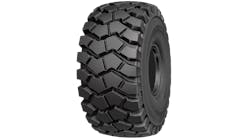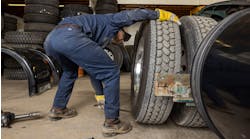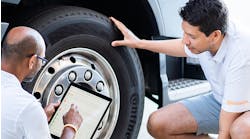Expert Opinions: Retread Suppliers Forecast Continued Growth
Few sectors of our industry have changed as dramatically as retreading. I recently asked several Tread Rubber and Tire Repair Material Manufacturers’ Group (TRMG) member companies to provide their outlook on the current and future state of retreading.
I received responses from Clif Armstrong, CEO and president of Marangoni Tread North America Inc.; Robbie Bushnell, vice president, tire repair products, Group 31 Inc.; Joe Casebere, technical general manager, Rema Tip Top North America Inc.; LaTres Jarrett, director of marketing, Bandag, U.S. and Canada, Bridgestone Americas Tire Operations; Bob Majewski, vice president and technical director, Acutread Alliance Group; and Karl Remec, business model leader, Michelin North America Inc. Here’s what they had to say.
What is the status of the current retread market?Armstrong: The word we hear most often when we ask our Marangoni independent dealers is “solid.” When asked to expand on this term, most talk about their business being ahead of the past few years but still not quite what was hoped for when tariffs were announced in February of this year.
Bushnell: I believe that the current status of retreading in North America is doing very well, even with inexpensive truck tires entering from China. While some fleets have chosen an inexpensive tire, many are finding out they do not have the quality casing allowing for multiple retreads. Cost-per-mile is very important, and the best truck tires still provide the lowest cost per mile after multiple retreads.
Casebere: As a company that supplies the retread and commercial market, we see a stable acceptance and need for retread and repair materials. Although the last few years have been robust in new tractor-trailer orders, retread volume shrunk for a time but should rebound as wheel positions adjust to new sizes and new wheel positions.Jarrett: It’s a dynamic time in the tire industry, particularly within the commercial tire segment.
All fleet owners are trying to maximize their investment and have an eye on lowering total cost of ownership across all their assets, including tires. Dealers continue to educate fleets on the benefits of retreads, the advancements in the retread manufacturing process and the impact retreads can have on a fleet’s bottom line. We anticipate that the retread market will continue to grow as fleet owners make changes to their business models to include more profitable, sustainable solutions.
Majewski: We are seeing a 4% increase in all our shops. We don’t see much of an increase in prices.
Remec: The pace of the current 2019 retread market has been steady, yet somewhat slower than expected, in comparison to 2018. We expected that the tariff situation on new, low-cost, imported tires from China would have had a bigger positive effect on the retread market. Are tariffs on Chinese tires helping the retread market?
Armstrong: In a word, yes. While the tariffs have not immediately translated into extraordinary growth for Marangoni Independent dealers, what they have done is spark a new sense of optimism and anticipation. Dealers are starting to talk about investing in their retread shops and upgrading equipment. Our industry has not seen this level of optimism in several years.
Bushnell: Tariffs can only help get the cost of an imported tire closer to the cost of a major brand here in the U.S., but we are still at a disadvantage. Imported tires certainly have some market share.
Casebere: Tariffs have slowed down the import of cheap price point products somewhat. The fact is that many of the Chinese partners in this level of manufacturing have over the last three years made product improvements and increased pricing because of better technology.
Jarrett: We continue to closely monitor the regulatory environment. The situation is very fluid, making it difficult to predict the future. Our focus is on educating fleets of all sizes about the many advantages retreads offer, and helping them understand that retreads are a smart business choice in any market condition.Majewski: We see the tariffs are going away behind the government’s back.
Remec: In theory, yes, because a tariff should raise the acquisition price of these new tires and fewer of them will enter the market and compete with retreaded tires for the same wheel positions. In the beginning, we saw better results, but they are moving tires through Canada and from Vietnam at the lower prices. Also, our vendors called and lowered prices by 14% going forward on all new orders.
Where do you see retread technology in 10 years?
Armstrong: Marangoni has been at the leading edge of retread technology with the splice-less Ringtread System. We will continue to develop new and better compounds to enhance the Ringtread System to meet the ever-changing fleet landscape. Retreading has always had the ability to adapt to changes quickly. As logistics continue to evolve, the retread companies will continue to react and respond. One need only look at the current changes in the market to see this change in action — for example, the Amazon” last-mile” effect. Retreading is a money-saving (option) for this ever-evolving business. We do not see this ability to adapt and enhance logistics operations changing in the future.Bushnell: The technology of truck tire retreading equipment has drastically changed in the last 10 years, and will certainly continue to evolve in the next 10 years. We are seeing computers running all of the equipment in the retread shop and it will continue to improve.
We are even seeing robotics and similar equipment being utilized, with the same technology that is used in new tire manufacturing.
Casebere: We believe there will be more automation in certain areas of the plant, especially in casing preparation, (plus) fewer steps in repair, curing methods and tire handling devices, requiring fewer retread employees.
Jarrett: The modern retread process has evolved significantly with the introduction of new technologies, and the latest innovations focus on the entire casing, not just the tread of a tire. For example, the Bandag retreading process includes multiple inspection points and state-of-the-art technology to determine if a casing is qualified for retreading.Looking ahead, we anticipate retread technology will become more sophisticated and cost-effective to make mobility more efficient for both the fleets we serve and our dealer partners.
Majewski: With technical processes like skive and repair, it’s pretty hard to automate, so buffing and building are what we focus on for automating. We also have the option of making our bladder presses robotic going forward. Another area where we need to improve is the amount of time spent lifting tires. The physical requirements of the job are a deal-breaker for some job candidates, so we must make it easier to keep and get good people.
Remec: Retread technology will develop along with new tire technology. Advancements in casing inspection technology and further automation of the retread process will continue to evolve toward making retreads safer on the road, more economical for fleet operators and better for the global environment. ■




